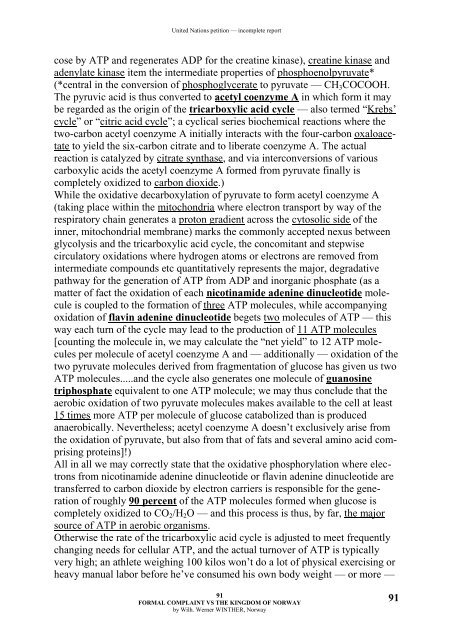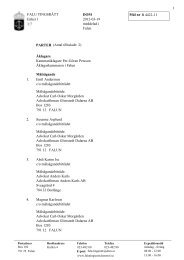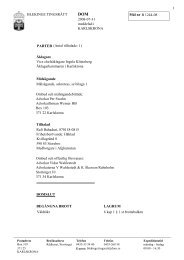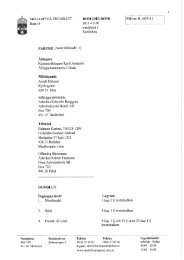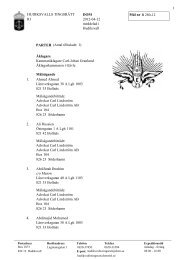FORMAL COMPLAINT - Sweden Confidential
FORMAL COMPLAINT - Sweden Confidential
FORMAL COMPLAINT - Sweden Confidential
Create successful ePaper yourself
Turn your PDF publications into a flip-book with our unique Google optimized e-Paper software.
United Nations petition — incomplete report<br />
cose by ATP and regenerates ADP for the creatine kinase), creatine kinase and<br />
adenylate kinase item the intermediate properties of phosphoenolpyruvate*<br />
(*central in the conversion of phosphoglycerate to pyruvate — CH3COCOOH.<br />
The pyruvic acid is thus converted to acetyl coenzyme A in which form it may<br />
be regarded as the origin of the tricarboxylic acid cycle — also termed ―Krebs‘<br />
cycle‖ or ―citric acid cycle‖; a cyclical series biochemical reactions where the<br />
two-carbon acetyl coenzyme A initially interacts with the four-carbon oxaloace-<br />
tate to yield the six-carbon citrate and to liberate coenzyme A. The actual<br />
reaction is catalyzed by citrate synthase, and via interconversions of various<br />
carboxylic acids the acetyl coenzyme A formed from pyruvate finally is<br />
completely oxidized to carbon dioxide.)<br />
While the oxidative decarboxylation of pyruvate to form acetyl coenzyme A<br />
(taking place within the mitochondria where electron transport by way of the<br />
respiratory chain generates a proton gradient across the cytosolic side of the<br />
inner, mitochondrial membrane) marks the commonly accepted nexus between<br />
glycolysis and the tricarboxylic acid cycle, the concomitant and stepwise<br />
circulatory oxidations where hydrogen atoms or electrons are removed from<br />
intermediate compounds etc quantitatively represents the major, degradative<br />
pathway for the generation of ATP from ADP and inorganic phosphate (as a<br />
matter of fact the oxidation of each nicotinamide adenine dinucleotide molecule<br />
is coupled to the formation of three ATP molecules, while accompanying<br />
oxidation of flavin adenine dinucleotide begets two molecules of ATP — this<br />
way each turn of the cycle may lead to the production of 11 ATP molecules<br />
[counting the molecule in, we may calculate the ―net yield‖ to 12 ATP molecules<br />
per molecule of acetyl coenzyme A and — additionally — oxidation of the<br />
two pyruvate molecules derived from fragmentation of glucose has given us two<br />
ATP molecules.....and the cycle also generates one molecule of guanosine<br />
triphosphate equivalent to one ATP molecule; we may thus conclude that the<br />
aerobic oxidation of two pyruvate molecules makes available to the cell at least<br />
15 times more ATP per molecule of glucose catabolized than is produced<br />
anaerobically. Nevertheless; acetyl coenzyme A doesn‘t exclusively arise from<br />
the oxidation of pyruvate, but also from that of fats and several amino acid comprising<br />
proteins]!)<br />
All in all we may correctly state that the oxidative phosphorylation where electrons<br />
from nicotinamide adenine dinucleotide or flavin adenine dinucleotide are<br />
transferred to carbon dioxide by electron carriers is responsible for the generation<br />
of roughly 90 percent of the ATP molecules formed when glucose is<br />
completely oxidized to CO2/H2O — and this process is thus, by far, the major<br />
source of ATP in aerobic organisms.<br />
Otherwise the rate of the tricarboxylic acid cycle is adjusted to meet frequently<br />
changing needs for cellular ATP, and the actual turnover of ATP is typically<br />
very high; an athlete weighing 100 kilos won‘t do a lot of physical exercising or<br />
heavy manual labor before he‘ve consumed his own body weight — or more —<br />
91<br />
<strong>FORMAL</strong> <strong>COMPLAINT</strong> VS THE KINGDOM OF NORWAY<br />
by Wilh. Werner WINTHER, Norway<br />
91


